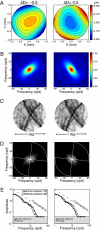Optimal defocus estimation in individual natural images
- PMID: 21930897
- PMCID: PMC3189032
- DOI: 10.1073/pnas.1108491108
Optimal defocus estimation in individual natural images
Abstract
Defocus blur is nearly always present in natural images: Objects at only one distance can be perfectly focused. Images of objects at other distances are blurred by an amount depending on pupil diameter and lens properties. Despite the fact that defocus is of great behavioral, perceptual, and biological importance, it is unknown how biological systems estimate defocus. Given a set of natural scenes and the properties of the vision system, we show from first principles how to optimally estimate defocus at each location in any individual image. We show for the human visual system that high-precision, unbiased estimates are obtainable under natural viewing conditions for patches with detectable contrast. The high quality of the estimates is surprising given the heterogeneity of natural images. Additionally, we quantify the degree to which the sign ambiguity often attributed to defocus is resolved by monochromatic aberrations (other than defocus) and chromatic aberrations; chromatic aberrations fully resolve the sign ambiguity. Finally, we show that simple spatial and spatio-chromatic receptive fields extract the information optimally. The approach can be tailored to any environment-vision system pairing: natural or man-made, animal or machine. Thus, it provides a principled general framework for analyzing the psychophysics and neurophysiology of defocus estimation in species across the animal kingdom and for developing optimal image-based defocus and depth estimation algorithms for computational vision systems.
Conflict of interest statement
The authors declare no conflict of interest.
Figures




References
-
- Vishwanath D, Blaser E. Retinal blur and the perception of egocentric distance. J Vis. 2010;10:26:1–16. - PubMed
-
- Kruger PB, Mathews S, Aggarwala KR, Sanchez N. Chromatic aberration and ocular focus: Fincham revisited. Vision Res. 1993;33:1397–1411. - PubMed
-
- Kruger PB, Mathews S, Katz M, Aggarwala KR, Nowbotsing S. Accommodation without feedback suggests directional signals specify ocular focus. Vision Res. 1997;37:2511–2526. - PubMed
-
- Wallman J, Winawer J. Homeostasis of eye growth and the question of myopia. Neuron. 2004;43:447–468. - PubMed
Publication types
MeSH terms
Grants and funding
LinkOut - more resources
Full Text Sources
Other Literature Sources

